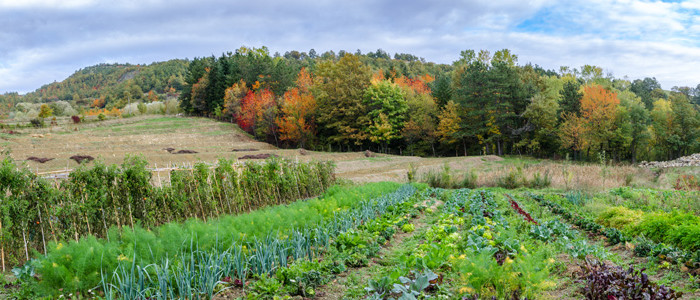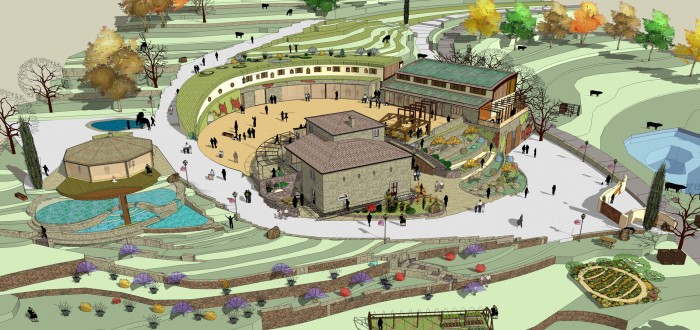La Fattoria dell’Autosufficienza: a permaculture farm and agritourism in Italy
In 2009 we decided to purchase 68 hectares of land in the Apennines, on the edge of the National Park of the Casentino Forests. The land had been abandoned for more than 10 years because considered to be not attractive for modern agriculture. In the family we are all experts on books, but no one knew the agriculture world. Anyway we decided to project a farm that can be self-sufficient in terms of food and energy with the aim to make it become a model for a new sustainable world.
Sustainability is the key word
For starting and managing the Farm we decided to follow the permaculture approach, whose main purpose is designing and organising human instalments that can be sustainable in the long term. In order to achieve that, permaculture is inspired by Nature’s principles and natural systems that have been developing on the planet over thousands of years.
Natural systems such as woods and forests are rich in biodiversity, with a huge production of biomass, they are extremely efficient in terms of recycle of nutrients and they are sustainable in the true sense of the word. Indeed, they are able to sustain themselves independently for thousands of years with no need for herbicides, fertilizers, irrigation, ploughing, etc. Italy itself would be solely covered with woods if there was no human being. So Nature tends to create forest ecosystems and the further we go from them, the more energy we have to introduce in our system to prevent Nature from establishing its harmony again.
The Farm takes shape
Starting from nothing, with no knowledge or expertise, with no habitable building and little time available has not been easy. Right away we decided to become a certified organic farm, even if at that time we hadn’t start any production yet. At the beginning we had to solve many bureaucratic issues linked to a world that we didn’t know and that is unprepared for these kind of projects. We lost the chance to receive public funds and we turned to few consultants who revealed not to be up to the project. We spent the first 2 years mostly on designing and on our personal education. At that time at the Farm there were only crumbling buildings, so we cleaned up the Farm centre, we turned an old cowshed into a storehouse and we planned the future of fields and buildings.
Starting from 2011, thanks to temporary wooden buildings, we were able to carry out our activities at the Farm in a more continuous way. First of all, we enclosed the fields in for preserving the crops from the beautiful and numerous local fauna. Since then we started to organise courses on permculture and experiment the cultivation of ancient varieties of fruit trees, natural and synergistic vegetable gardens, small fruits, food forests, raised garden beds, ancient grains, beans, spirals of aromatic herbs, as well as raising small yard animals and seeding through seed balls. We built swales, greenhouses, fences, dry stone walls, ponds, terraces, etc.
Learning from mistakes
All these experiences have led us to determine the value and the limits of the different systems, to realise the mistakes we were making and especially to understand that sometimes what we thought was good permaculture was not so good after all. To sum up, the purpose of permaculture should be to work little and have a good production along with a positive ecological impact. However, many times we found ourselves experimenting something that we’d read in books thinking to give life to great permaculture projects and then realised, though profit and loss analysis, that the results were not positive if compared to time, energy and materials employed.
We made the same mistake during the construction works of the main building that started in April 2014 and ended in August 2016. Starting from stone ruins with part of the roof and walls that had crumbled, a beautiful 500-square-meter agritourism was built following the principles of green building. During the construction we relied on all our theoretical knowledge in order to have a very energy-efficient and green building that kept at the same time the historical features required by the municipality of Bagno di Romagna.
Now the agrtourism has a structure which is entirely made of local stones, 100% natural lime, roof and floors made of Tuscan firs, inner insulation realised with hemp and lime walls, roof insulation with 20 cm of wood fibre and 5 cm for ventilation, wall heating system, heat recovery ventilation system, wood stove, two puffers that contain 1000 litres each, energy efficient window fixtures with thermal transmittance value 1,1 and naturally painted, wooden floor treated with natural oil, rainwater tank, wooden furniture, organic mattresses and linens for the bedrooms.
The result is something beautiful and extraordinary where some solutions have revealed to be forward-looking while others, such as the great quantity of complex plumbing and heating systems, turned out to be not adapt for the renovation of a listed stone building. Again we found ourselves to apply what is a good practice on paper, but that at the end revealed to be not suitable for the context in which was applied.
So the great step of this year, beside finally having a great building for hospitality, was to understand that there are permaculture examples that cannot be taken as replicable models before having done a careful profit and loss analysis, which is one of the main tools for designing a permaculture farm.
Newsletter
ARGOMENTI
- Activities (8)
- Attività (10)
- Attrattive (16)
- Cosa fare (22)
- Farm products (4)
- Fattoria dell'autosufficienza (62)
- Fattoria dell'autosufficienza (40)
- Fauna (8)
- Flora (5)
- I nostri modelli (15)
- Istruzioni per viaggiare (2)
- News (63)
- News (97)
- Our models (14)
- Permacultura (30)
- Permaculture (23)
- Prodotti della fattoria (4)
- Senza categoria (2)
- Senza categoria (4)
- Things to do (22)
- Tourist attractions (15)





